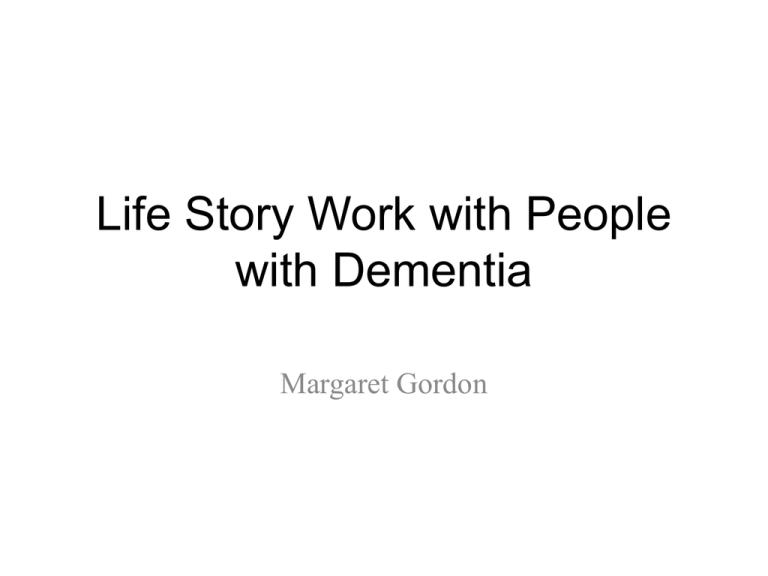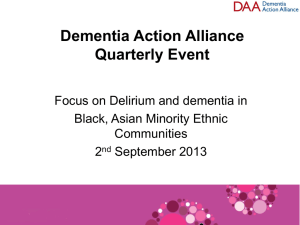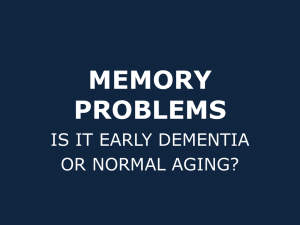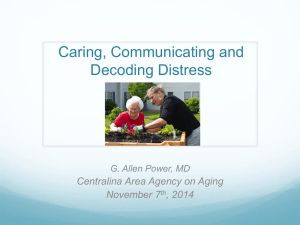Life Story Work with People with Dementia
advertisement

Life Story Work with People with Dementia Margaret Gordon We Shall Explore • What Life Story Work is • Why Life Story Work (LSW) is relevant and essential in dementia care • The benefits and risks in undertaking it • Research which supports it • Some practical tips for undertaking it Life Story Work • Originates from adoption and foster care work • Involves the intentional or planned efforts to encourage people with or without dementia to think about, remember, share and record information about themselves • A loose rather than precise term, which draws information from a variety of sources and can result in various formats Different formats of Life Stories • • • • • • • • • Commercially produced Life History Book Loose leaf Life Story Book Memory Box Audio or Video recordings Annotated Photo albums Augmented Family Tree Illustrated Life Line Story Board/Collage Musical Biography “This is Me” (Alzheimer’s Society booklet) What is Life Story work? • • • • • • Who the person is and to whom she is connected Where the person originated for and where they lived What the person has done at different times What has been important to them and still is. What they would like people to know about them What values have been important to them and may still be important • What the person makes of his life experience and may want his children, grandchildren or family to appreciate So Life Story work--• Epitomises person-centred and relationship centred care. It enables us to realise quality care, tailored to meet individual need. “It is in the fine grain of care that quality care is really experienced, the tiny details that show that our uniqueness has been recognised.” Prof. Mary Marshall in preface to “Living Fuller Lives” (Bamford Review,2007) “High quality care is synonymous with respecting individuality” Faith Gibson, 2004:55 Why LSW with People with Dementia ? Bill Mearns (2007) said that Life Story Work with people with dementia is “as critically important as lotions and potions.” Why? Several reasons Why LSW? • It draws on residual long term memory • It provides a medium for communication that promotes self esteem and well-being • It safeguards personal identity • It maintains links with familiar people which lessens encroaching isolation • It increases carers’ understanding of confused or agitated behaviour • It assists care-planning, person-centred and relationship centred care LSW, a valuable communication tool • Dementia makes recall difficult • Recognition is a more enduring feature of memory • A person is more able to recognise past events than actively recall them (Lise Naes , 1998:120) “As we go through life we build up a personal history with its unique mixture of joys and pleasures, sadness and pain. Our sense of who we are is linked to that history and if we lose that history, we lose something of ourselves. For a person with dementia who is losing their memory and trying most of the time to make sense of who they are, a life story book can be an atlas, the compass, the guide to finding their self.” (Tom Kitwood,1992.) Why LSW? “Gaining better knowledge and understanding of the factors influencing behaviours and emotions transforms attitudes and fosters greater sensitivity, thoughtfulness and empathy towards the individual” (B.Pointon, in G.Stokes, 2010) Understanding through LSW • People with A.D. have lost their ability to lay down new memory for faces and places and use their old memory to interpret the environment. “What we see is strongly influenced by the concepts we access from our memory archives from the temporal lobe and “map” onto the visual perceptions in the occipital lobe” (E. Milwain, 2010) Understanding Behaviour Graham Stokes (2010) message is that people are not only unique but stay true to themselves in dementia • The rock man • “They were never close” • The colour purple in “And Still the Music Plays; stories of people with dementia” Learning about a person’s past helps our understanding or interpretation of present behaviour. “A person with dementia will behave in a way ”The best vantage point that is appropriate in the for understanding light of how they behaviour is from the interpret what is internal reference of the happening around and individual himself” to them. This is the Carl Rogers, 1951 world we need to enter.” Graham Stokes, 2010 Features of memory loss through dementia • Memories of childhood and early adulthood are very strong. New memories are integrated into these. • Emotion boosts the release of additional neurotransmitters into the temporal lobe to consolidate memory, so emotional memories are stronger than neutral memories. • Repeated experiences last (though the context is forgotten) • But certain experiences of strong emotional content that are not repeated we carry (e.g. wedding day, births of children, first car.) This knowledge aids ideas for LSW Themes or “fishing pools” (J. Birren, 2001) • • • • • • • • • • Earliest memories Childhood and family life Schooldays Favourite teachers Impact of teachers Firsts – pay/job/home/car/date Working life Going out and having fun Wedding/s Babies and children • • • • • • • • • • Pets loved Food loved and made Celebrations of the past Holidays or days out Hobbies Games played Organisations supported Religious or spiritual life Travel enjoyed Sports played of hated Be aware of all of the senses triggering memories. Can make use of this in LSW • • • • • • Sight Smell Sound Touch Taste Environment The Skills needed for LSW The process is more important than the product . (F. Gibson, 2004) • • • • • • Active listening Sensitive, probing ?’s Paraphrasing Reflecting feelings Recapping Recording as service user wishes Family Carers • Involve family carers if at all possible • They need to understand the benefits of the work before LSW starts. (This is not a test of memory.) • Family carers can tell the stories behind the photos or memorabilia which people will recognise, but may not recall. • Do not accept any materials for the LSW without explanation or annotation. Where no family ---Ideas of materials for LSW • • • • • • Computer images of e.g. working life, hobbies. Letters/stories from friends or visitors Photos or recipes of favourite food Postcards of places lived or loved or visited Magazine cut-outs of places once visited/loved Current photos of family home, town, pub, animals similar to that once owned. • Tourism fliers of areas known to be significant • Visiting the important place, pub, street, school, park . The risks in LSW? That painful memories will be recalled But “Remembering and sharing painful life experiences promotes greater emotional healing and acceptance of unfortunate circumstances.” Moreover “Remembering the way difficult times were faced in the past helps people face difficult times today” (Kunz, J and Soltys,F. 2007:41) The risks? Abuse disclosed • Then must be dealt with in accordance with the procedures for Safeguarding Vulnerable Adults. • Duty to report to line manager. • Protection supersedes confidentiality. The risk of the re-emergence of past trauma Memories of past trauma can re-emerge sometimes for the first time under the impact of dementia. Old psychic defences have given way to longburied memories Mostly distorted , but believe or suspend judgement Other risks That family secrets may be revealed But, --- structured approaches may be needed to promote quality of life. The need to put one’s life into perspective becomes an increasingly important task as one ages (Butler, Webster, Gibson, Haight, Schweitzer, Kunz and Soltys) but older people have fewer and fewer contacts to reminisce with as significant people die, become disabled or move into care. The four greatest risks for older people with dementia are • Social isolation • Boredom • Being disregarded as an adult person • Feeling that they are useless The Benefits of LSW • It is an enjoyable activity for the person, staff and family. It will create a legacy for the family. • It enhances self worth and a unique identity • It recalls people skills and strengths • It identifies past interests, likes and dislikes which aid person-centred planning • It is cheap but not costless ,and it is low risk • It builds understanding and friendships • The person’s wellbeing will be improved and so will yours! Researched benefits • A controlled pilot pre-test post -test study by Haight and Gibson(2004) undertaken in 6 facilities in N.I with 30 residents aged 60-90 with a diagnosis and pre-test MMSE score of 17. • Randomly selected and 6 weekly structured sessions of life story work. • Control group continued to receive ordinary care. Results Statistically significant results obtained on 4 measures • Cognition – Mini Mental State Examination • Depression – Cornell Scale for Depression • Mood – Alzheimer’s Mood Scale • Communication – Communication Observation Scale Change in right direction obtained on • Independence – Functional Independence Scale • Behaviour _ Memory and Behaviour Checklist. The Northern Health and Social Care Trust Project with RNNI • Yvonne Carson Senior Health Promotion Officer working with the RNNI. 4 half day sessions to train and encourage staff. Northern Trust Life Story Book template created. • No dispute about its usefulness for residents and staff but immense problems in staff getting time to implement. • Has led to Big Lottery funding for further LSW NICE/SCIE Dementia Guidelines 42, 2006 NICE and SCIE advocate “individual biography” and reminiscence as a non-pharmacological intervention for behaviours which challenge us Practical tips • Informed consent or assent is essential • Dedicate time in private, being sensitive to mood, health, energy levels. Use the LSW information often. • Include only what the person WANTS to include . This is not an autobiography. • Be inquisitive – pick up information from old newspapers (e.g.50 years ago sections in local newspapers), or from libraries, visitors etc. • Use multi-sensory triggers to aid recall . • Keep it simple and a natural part of your caring role .Have LSW on job descriptions and supervision agendas Practical Tips (continued) • A loose leaf folder is easier to compile, -photo or article on one side , text on other. • Copy everything donated by family. • Use the first person tense and words of the person with dementia. If using computer, encourage person to chose font size and type. Check you are using their preferred verb or adjective. • Use evaluative words as guided by the person.eg. “My cheeky dog Barney””My lovely mum” “My beautiful wife”.”My horrible/great school.” Practical tips • Provide empathetic listening to sad stories • Respect information that the person does not want included. He may have benefitted from talking about it. • Encourage reflections on life and past achievements Life Story Work is done • • • • To improve the life of a person with dementia It will enrich yours It enlarges our capacity to feel (Gibson,2004) It is a valuable tool for communication and understanding • It becomes a passport when transition to hospital or another home is necessary • It is a legacy for family and friends. References • Birren, J. & Cochrane, K. (2001)“Telling the stories through Guided Autobiography Groups” The John Hopkins University Press • Gibson, F. (2004)“ The Past in the Present” Health Professionals Press • Milwain, E. Journal of Dementia Care (2010) • Kitwood, T “Dementia Reconsidered: the person comes first.” Buckingham: Open University Press • Kunz, J and Soltys, F.(2007) “Transformational Reminiscence.. Life Story Work” Springer Publishing Co. • Naes, L. in “Reminiscence in Dementia Care.” (1998) Age Exchange • Stokes, G. (2010) second edit. “and Still the Music Plays. Stories of People with Dementia.” Hawker Pubs. London











